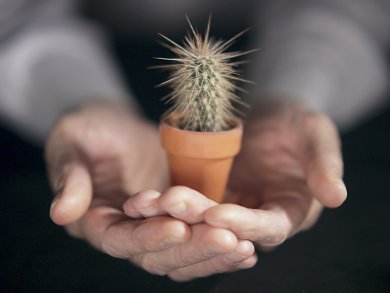Highlights from this months issue of the GDCh journal, Chemie in unserer Zeit:
My small green cactus
Plants take in carbon dioxide and transform it into carbohydrates. How do plants get such an extremely inert compound to react? What do the acceptor and the catalyst look like? Let’s follow the fate of a single carbon atom starting from CO2 up to sugars. It will be a path full of surprises and before it’s over, we’ll have to respectfully admit that plants are really brilliant chemists.
Diamondoids
Although the class of diamondoids has been known for many decades, the renaissance of these molecular nanodiamonds has only begun very recently. In the last century there has already been a great deal of research work and some relevant applications in the area of adamantane (rarely diamantane or triamantane) but the higher diamondoids were virtually left unexplored. The selective chemical modification of diamondoids represents a formidable scientific challenge but inherits the potential for many advances and unique applications. While other nanoscale diamond materials often have problems with size distributions and purity diamondoids possess well defined structures and are of high purity. Only seven years after the first isolation of higher diamondoids from crude oil we conclude that research and development in this field proceeds at an amazing pace.
Global harmonized system
In the dangerous goods regulations there is no clear rule for the naming of dangerous goods which are not directly registered in the dangerous goods list. The use of different names for the same substances makes communication about these goods difficult. On the other hand, many chemical names include special characters (e.g. Greek letters, umlauts etc.) which are not easily transferable electronically. This results in a potential for substantial error in the case of an incident with dangerous goods. To solve this problem a database is recommended with uniform names which are easily transferable electronically.
Active substances from plants
Due to its deepened natural material research the transdisciplinary biodiversity research offers new options to therapeutical challanges of the 21st century. Besides phytochemicals, known for centuries, these natural materials also include recently known material such as antiviral active high polymer polyphenols of Mediterranean rockroses or new kinds of antiadipos active bitter-tasting compounds. Natural ressources are invaluable. To protect and preserve these, detailed knowledge of biodiversity on Earth and its embedding in the biogeosystem is required.
Robert Havemann
In the uncommon course of life of the German physical chemist and philosopher Robert Havemann resistance activities against National Socialism – for what he was sentenced to death in December 1943 – play a special role. Superiors, friends and Havemann himself led a successful struggle to prevent the execution. By declaring his research work to be highly essential to the war a research laboratory was established solely for Robert Havemann to continue his work from within the prison of Brandenburg-Görden. In April 1945 he was liberated by the Red Army.




